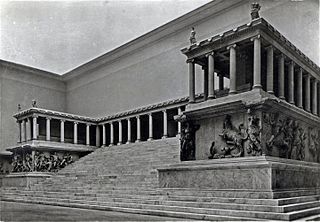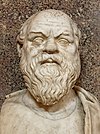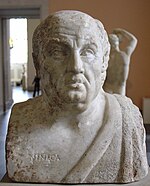Year 120 (CXX) was a leap year starting on Sunday of the Julian calendar. At the time, it was known as the Year of the Consulship of Severus and Fulvus. The denomination 120 for this year has been used since the early medieval period, when the Anno Domini calendar era became the prevalent method in Europe for naming years.

Year 200 (CC) was a leap year starting on Tuesday of the Julian calendar. At the time, it was known as the Year of the Consulship of Severus and Victorinus. The denomination 200 for this year has been used since the early medieval period, when the Anno Domini calendar era became the prevalent method in Europe for naming years.

A herma, commonly herm in English, is a sculpture with a head and perhaps a torso above a plain, usually squared lower section, on which male genitals may also be carved at the appropriate height. Hermae were so called either because the head of Hermes was most common or from their etymological connection with the Greek word ἕρματα, which originally had no reference to Hermes at all. The form originated in ancient Greece, and was adopted by the Romans, and revived at the Renaissance in the form of term figures and atlantes.

The Pergamon Altar was a monumental construction built during the reign of the Ancient Greek King Eumenes II in the first half of the 2nd century BC on one of the terraces of the acropolis of Pergamon in Asia Minor.

The Severan Tondo or Berlin Tondo from c. 200 AD is one of the few preserved examples of panel painting from Classical Antiquity, depicting the first two generations of the imperial Severan dynasty, whose members ruled the Roman Empire in the late 2nd and early 3rd centuries. It depicts the Roman emperor Septimius Severus with his wife, the augusta Julia Domna, and their two sons and co-augusti Caracalla and Geta. The face of one of the two brothers has been deliberately erased, very likely as part of damnatio memoriae.

The Pseudo-Seneca is a Roman bronze bust of the late 1st century BC that was discovered in the Villa of the Papyri at Herculaneum in 1754, the finest example of about two dozen examples depicting the same face. It was originally believed to depict Seneca the Younger, the notable Roman philosopher, because its emaciated features were supposed to reflect his Stoic philosophy. However, modern scholars agree it is likely a fictitious portrait, probably intended for either Hesiod or Aristophanes. It is thought that the original example was a lost Greek bronze of c. 200 BC. The bust is conserved in the Museo Archeologico Nazionale, Naples.

The Staatliche Museen zu Berlin are a group of institutions in Berlin, Germany, comprising seventeen museums in five clusters; several research institutes; libraries; and supporting facilities. They are overseen by the Prussian Cultural Heritage Foundation and funded by the German federal government in collaboration with Germany's federal states. The central complex on Museum Island was added to the UNESCO list of World Heritage Sites in 1999. By 2007, the Staatliche Museen zu Berlin had grown into the largest complex of museums in Europe. The museum was originally founded by King Friedrich Wilhelm III of Prussia in 1823 as the Königliche Museen.
The Antikensammlung Berlin is one of the most important collections of classical art in the world, now held in the Altes Museum and Pergamon Museum in Berlin, Germany. It contains thousands of ancient archaeological artefacts from the ancient Greek, Roman, Etruscan and Cypriot civilizations. Its main attraction is the Pergamon Altar and Greek and Roman architectural elements from Priene, Magnesia, Baalbek and Falerii. In addition, the collection includes a large number of ancient sculptures, vases, terracottas, bronzes, sarcophagi, engraved gems and metalwork.

Delphi Archaeological museum is one of the principal museums of Greece and one of the most visited. It is operated by the Greek Ministry of Culture. Founded in 1903, it has been rearranged several times and houses the discoveries made at the Panhellenic sanctuary of Delphi, which date from the Late Helladic (Mycenean) period to the early Byzantine era.

The Berlin Foundry Cup is a red-figure kylix from the early 5th century BC. It is the name vase of the Attic vase painter known conventionally as the Foundry Painter. Its most striking feature is the exterior depiction of activities in an Athenian bronze workshop or foundry. It is an important source on ancient Greek metal-working technology.

The Fragment from the tomb of Nikarete from the third quarter of the fourth century BC, found near Athens is displayed today in the Antikensammlung of the Altes Museum in Berlin.

The Attic Grave relief of Thraseas and Euandria from the middle of the fourth century BC is kept in the Pergamonmuseum and belongs to the Antikensammlung Berlin.

A Relief depicting a Roman legionary is located in the Pergamonmuseum and belongs to the Antikensammlung Berlin. The relief was created at the end of the first century AD and was discovered in 1800 at Pozzuoli.

The statue of Pericles with the Corinthian Helmet is a lost, life-sized statue of the Athenian statesman and general Pericles. Today, only some of the base survives. Four Roman Imperial-era marble busts modelled after the head of the statue are known.

The Grave relief of Publius Aiedius and Aiedia is an ancient Roman grave relief from the first half of the first century, now kept in the Pergamonmuseum / Antikensammlung Berlin, with Inventory number SK 840.
Elisabeth Rohde was a German classical archaeologist.

The Green Caesar is a portrait of Gaius Julius Caesar made of green slate kept in the Antikensammlung Berlin, which was probably made in the first century AD.

The statuette of hoplite found at Dodona is an archaeological find which was purchased in 1880 and is hosted today in Berlin at the Altes Museum
The Athena with cross-strapped aegis is an ancient statue of the Greek goddess Athena, which was made around AD 150 and is now displayed in the Antikensammlung Berlin.


















